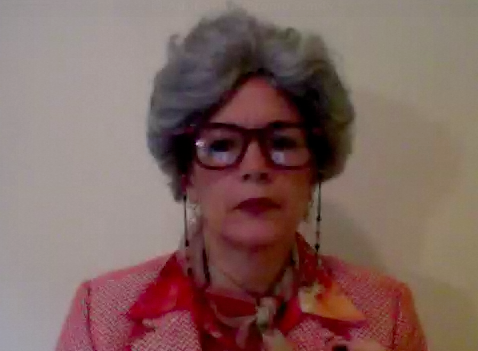Category: Motivating staff
Posted by Dr. El - January 6, 2015 - Business Strategies, Common Nursing Home Problems and How Psychologists Can Solve Them, McKnight's Long-Term Care News, Motivating staff, Psychology Research Translated

Here’s my latest article on McKnight’s Long-Term Care News:

Standing by the salad bar in the newly opened restaurant, I recoiled at the sign that read, “Please don’t use your hands.” I suggested to the manager that the notice should instead advise diners to “Please use the serving spoons.” My recommendation for that short-lived establishment followed what’s known as “nudge principles.”
What are nudge principles?
Nudge principles use basic human tendencies to encourage people to engage in positive behavior. One aspect of nudge is to craft messages, like how to use the salad bar, in ways that are more likely to result in positive action.
Another aspect, according to Tori DeAngelis in Coaxing Better Behavior, is to harness “our less laudatory traits — short-sightedness, inertia, inflated optimism and our tendency to submit to peer pressure.”
Research shows people have a “default bias” which makes them more likely to choose the first option in front of them. Putting fresh fruit before the desserts in a cafeteria line would be one way of making positive use of this bias. Another is creating a default option that enrolls employees in a retirement account rather than requiring them to opt into the program.
Care must be taken to create good default options, though, or they can backfire. One poorly constructed automatic retirement account enrollment, for instance, resulted in more individuals contributing, but fewer dollars set aside overall. Why? The default choice set aside less money than what people might have chosen if they’d given it more thought.
Starting with the end result
Some “nudge” researchers identify the outcome they want to see and then look at what methods are most successful in achieving that outcome. In one study, the British government sent letters to delinquent taxpayers, saying, for example, “You are one of the few who have not paid us yet.” They altered the wording of the letters to see which phrasing would result in the greatest collection of outstanding funds — and retrieved an extra $15 million overall.
Applying nudge principles in LTC
For the entire article, visit:

Posted by Dr. El - September 29, 2014 - Aunt Sylvia, Business Strategies, Motivating staff, Talks/Radio shows

Join Dr. El
Thursday, October 2nd
at 2pm Eastern Time (1pm Central Time)
for a
FREE Webinar on
Using Psychology to Motivate Staff
sponsored by EmLogis
To register:

Aunt Sylvia Motivates the Staff: Click here or view below: http://youtu.be/byhU_OgiIaY
About the Webinar:
Create a sense of hope and momentum throughout your organization by engaging in simple practices that create tremendous change. Join psychologist Dr. Eleanor Feldman Barbera as she discusses practical techniques based on psychological principles that promise big impact in motivating your staff. Register now for this free webinar on October 2nd, 2014 at 1PM – space is limited!
What you will learn:
• How to turn energy-zapping organizational habits into systems that revitalize and invigorate your teams
• Practical, easy-to-implement ideas your staff will notice immediately
• Ways to build small changes into large and lasting impact
Who should attend this webinar:
• Administrators and assistant administrators
• DONs, ADONs, department heads, nursing supervisors, and charge nurses
• Staff training coordinators
• Human resource department staff
Posted by Dr. El - August 26, 2014 - Aunt Sylvia, Business Strategies, Communication, Motivating staff

Join Dr. El
Thursday, August 4th
at 2pm Eastern Time (1pm Central Time)
for a
FREE Webinar on
5 Ways to Encourage Teamwork in Your LTC Facility
sponsored by EmLogis
To register:

Aunt Sylvia at the nursing station, discussing teamwork: Click here or view below: http://youtu.be/7KTqBbjaJro
About the Webinar:
How much more could your facility accomplish in a day, week or month with more effective teamwork?
Are you building a culture of teamwork? Do you make it okay to ask for help? Can better teamwork be an affordable way for your facility to keep employees longer and make residents happier?
Join us for a live webinar on the 4th of September 2014 at 1pm CST to learn 5 (or more!) steps that you can take to encourage teamwork in your long-term care facility with expert Dr. Eleanor Barbera. Do you have very specific teamwork challenges? Dr. El will be available at the end of the webinar to answer your questions live!
Attend and you will learn:
Organizational strategies for fostering teamwork
Practical techniques for managers, department heads, supervisors, and charge nurses that enhance team relationships
Ways to address challenging staff behaviors
Who should attend this webinar:
Administrators and assistant administrators
DONs, ADONs, department heads, nursing supervisors, and charge nurses
Staff training coordinators
Human resource department staff
Posted by Dr. El - July 16, 2014 - Motivating staff, Stress/Crisis management, Talks/Radio shows

Join Dr. El
Thursday, July 17th
at 2pm Eastern Time (1pm Central Time)
for a
FREE Webinar on
Preventing Burnout in Long-Term Care
sponsored by EmLogis
To register:
About the webinar:
Long-term care can be a stressful work environment, contributing to job dissatisfaction, turnover, injury and absenteeism. Join psychologist Dr. Eleanor Feldman Barbera as she discusses factors contributing to job burnout and offers practical, effective ways for managers and direct care staff to reduce and manage stress.
What you will learn:
Factors contributing to burnout in LTC
Strategies for managers that decrease work pressure among staff
Practical techniques to reduce stress for all staff members
Who should attend this webcast:
Administrators and assistant administrators
DONs, ADONs, and department heads
Staff training coordinators
Human resource department staff
All direct care staff
Posted by Dr. El - June 12, 2014 - Business Strategies, Communication, Customer service, Engaging with families, McKnight's Long-Term Care News, Motivating staff, Resident care

Here’s my latest article on McKnight’s Long-Term Care News:

At the front desk, the workers were having an argument. Some residents watched the proceedings with interest and others with expressions of alarm. A waiting family member shifted from one leg to another and began sighing with exasperation as the loud conversation wore on without her presence being acknowledged.
We may talk about the term “customer service” and ask our staff members to avoid public arguments like the one above, but nevertheless, similar situations happen every day. Why does it matter so much? Using the model of the family as a guide, I discuss the psychological importance of good customer service in all our interactions.
With other staff members – Just as the relationship between parents forms the foundation of a family, our relationships with our coworkers are the foundation of good customer service.
o As shown in the above example, the residents observe how we treat one another. If our conversations are respectful and collegial, residents feel comfortable discussing concerns because they perceive their caregivers to be levelheaded and understanding. Angry, shaming interactions between staff members create an unsafe environment, making residents less likely to share information — including details that may affect medical care.
o Difficult interactions with coworkers are frequently transmitted to resident care. This is known in psychological terms as displacement. In the classic case, the boss yells at the father, who comes home and yells at his wife, who yells at the kid, who kicks the dog. If the nursing supervisor publicly criticizes the nurse who then chastises the aide, the residents are likely to be on the receiving end of the aide’s aggravation. Alternatively, if the nursing supervisor compliments the nurse who in turn praises the aide, the residents are more like to be met with a cheerful, upbeat caregiver.
o How senior staff members talk to subordinates is passed along to the next level of subordinates, not just through displacement, but also through modeling. Senior staffers are showing through example “how we handle things here.” When an administrator uses “teachable moments” to calmly point out what aspects of a crisis were managed well and what could be done differently for mismanaged parts, this becomes its own teachable moment in terms of how to provide constructive feedback.
For the entire article, visit:

Posted by Dr. El - June 3, 2014 - Business Strategies, Motivating staff, Talks/Radio shows

Join Dr. El
Wednesday, June 4th
at 2pm Eastern Time (1pm Central Time)
for a
FREE Webinar on
Creating a successful employee recognition program
sponsored by EmLogis
To register:

Posted by Dr. El - May 29, 2014 - Business Strategies, McKnight's Long-Term Care News, Motivating staff

Here’s my latest article on McKnight’s Long-Term Care News:

One of my recent posts, Employee recognition programs: What works, focused on the benefits of recognition and key points in choosing a recognition program. Now I’d like to address how to implement your chosen employee recognition program so that it becomes an energizing and integral part of your organization, rather than a short-lived promotion that fizzles after its initial burst of enthusiasm.
Here are some tips to ensure a long, useful life for your recognition program:
1. Establish a budget — Most companies spend between 0.5% and 3% of their payroll budget on employee recognition, with the average being 2%. Decide whether your distribution will be centralized, department-specific, or a combination of the two. Human resource personnel most frequently direct the programs (55% in a 2013 WorldatWork study, with a variety of staff taking responsibility at the other 45% of companies studied).
2. Determine how success will be measured — There are many ways to gauge the results of your efforts, including employee and resident satisfaction surveys, the level of participation in the program, and turnover rates. It also may be useful to have goal-specific measures, such as “number of infections” for a program designed to improve infection control procedures.
3. Train management staff on basics — It’s essential for the success of your program to have buy-in from senior staff members. Educate them on general recognition strategies such as when and how to acknowledge employees for best effect and the importance of their role in the project.
4. Design the program and get feedback — While you may have decided the broad focus of your program, now is the time to get specific. Exactly how will your program work? Who is eligible? What rewards will be offered? Who will be offering them? Try to create a simple program to provide meaningful, desirable rewards that are distributed fairly. Get feedback from your team to ensure the feasibility of the ideas and to increase their support for the enterprise.
For the entire article, visit:

Posted by Dr. El - May 5, 2014 - Business Strategies, Motivating staff, Talks/Radio shows

Join Dr. El
Thursday, May 8th
at 2pm Eastern Time (1pm Central Time)
for a
FREE Webinar on
Reducing Turnover in LTC
sponsored by EmLogis
To register:

Posted by Dr. El - February 7, 2014 - Business Strategies, McKnight's Long-Term Care News, Motivating staff, Psychology Research Translated

Here’s my latest article on McKnight’s Long-Term Care News:

“They keep giving me these new aides and they don’t know what they’re doing,” a disgruntled resident commented during a psychotherapy session.
“You’re not the first person to tell me that,” I replied, looking for a way to acknowledge her experience without criticizing either the facility or the new aides. “You have the honor of training them.”
“Yes, if they’d listen,” she said with an edge in her voice. “But it’s a lot of work.”
The turnover rate in long-term care is a significant problem, with rates ranging from 55% to 75% for nurses and aides and sometimes over 100% for aides alone. Having personally witnessed a great deal of turnover during my years in LTC, I was curious about why the rate is so high and what could be done about it. I turned to the research to find the answers.
Costs of turnover
I was dismayed by a study that suggested that the persistence of turnover over the years might be because nursing homes could save money by treating their staff like a never-ending supply of fast food workers and avoiding investment in training and retention practices.
To my great relief, I found data indicating that there are many costs associated with turnover, including increased hospital readmission rates, high employee replacement costs, loss of productivity, poorer quality of care, a decrease in staff and resident morale, increased work stress, job dissatisfaction, increased accident and absenteeism rates, increased overtime costs, and resident and family dissatisfaction. Aside from the moral reasons to reduce turnover, it’s also worthwhile on a strictly monetary basis. An estimate of the per-worker cost of turnover in the general U.S. economy is about 20% of the worker’s annual compensation amount.
Much of the literature looked at turnover in aides and nurses and while the findings weren’t always consistent between studies, the following factors were associated with job dissatisfaction and workers leaving their employers.
Factors associated with turnover
For the entire article, visit:

Posted by Dr. El - January 22, 2014 - Business Strategies, Communication, McKnight's Long-Term Care News, Motivating staff

Here’s my latest article on McKnight’s Long-Term Care News:

After Ms. Ryan’s psychotherapy session, I stopped at the nursing station and asked the nurse for the name of her aide. The nurse pointed to a uniformed woman right next to me, who turned and asked me with hostility, “How do you know it was me?” Surprised, I responded, “I just wanted to tell you Ms. Ryan was really happy with how you did her hair today. She wanted me to thank you for her.” The aide appeared stunned. The nurse commented, “We usually expect complaints, not compliments.”
If your staff is more prepared for criticism than praise about its work, it’s an especially good time to consider positives of an employee recognition program.
Benefits of employee recognition programs
Studies show that employee engagement, productivity and customer service are about 14% better in companies where recognition occurs, compared to companies without a program that acknowledges their efforts. In addition, companies with an effective recognition program have a 31% lower voluntary turnover rate than those with an ineffective program.
Ineffective programs tend to reward employees for tenure rather than performance. (Apparently those 10-year pins aren’t making the desired impact.) Effective programs offer specific feedback about the actions of workers and make it easy to provide that feedback.
Interestingly, there’s a substantial disconnect between the 80% of senior leaders who believe their employees are being recognized on a monthly basis and the 22% of individual workers who report their peers being acknowledged that frequently.
The Oregon Health Care Association’s Staff Retention Toolkit is an excellent resource for information about different types of Employee Recognition Programs (see page 46 in it). The toolkit notes these additional benefits:
For the entire article, visit:














